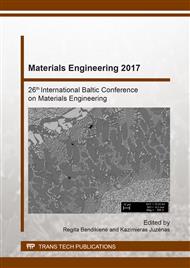[1]
R.G. Charles, Conductive molding compositions and articles therefrom, WO 00/49076, (1999).
Google Scholar
[2]
A. Taeger, M. Gedan-Smolka, B. Lilie, D. Krug, Polymere Antistatikadditive für Holzwerkstoffe, Holztechnologie. 52 (2011) 23-27.
Google Scholar
[3]
A. Taeger, M. Gedan-Smolka, M. Tuschla, D. Lehmann, IPF Dresden, Beschichtung für Holzmaterialien und Verfahren zu ihrer Herstellung, DE 10 806 (2009) 2007 000.
Google Scholar
[4]
K. Schubert, M. Gedan-Smolka, Synthesis and characterization of new oligomeric/polymeric antistatic additives for sheet molding composites, J. Appl. Polym. Sci, 134 (2017) 44741.
DOI: 10.1002/app.44741
Google Scholar
[5]
DIN EN ISO 3672-2: Ungesättigte Polyesterharze, Herstellung von Probekörpern und Bestimmung von Eigenschaften; Berlin: Beuth Verlag (2002).
DOI: 10.31030/9254910
Google Scholar
[6]
M. Gedan-Smolka, A. Müller, U. Gohs, A. Calvimontes, Electron pretreatment of sheet molding compounds (SMC), Progress in Organic Coatings. 72 (2011) 159-167.
DOI: 10.1016/j.porgcoat.2011.02.002
Google Scholar
[7]
DIN EN ISO 2555: Harze im flüssigen Zustand, als Emulsionen oder Dispersionen, Bestimmung der scheinbaren Viskosität nach dem Brookfield-Verfahren; Berlin: Beuth Verlag, (1999).
DOI: 10.31030/2832296
Google Scholar
[8]
DIN 53018 Teil 1: Messung der dynamischen Viskosität newtonscher Flüssigkeiten mit Rotationsviskosimetern; Berlin: Beuth Verlag, (1976).
Google Scholar
[9]
M. Gruskiewicz, J. Collister, Analysis of the thickening reaction of a sheet molding compound resin through the use of dynamic mechanical testing, Polym. Composites. 1 (1982) 6-11.
DOI: 10.1002/pc.750030103
Google Scholar


